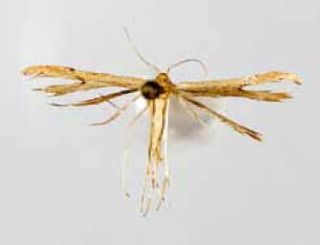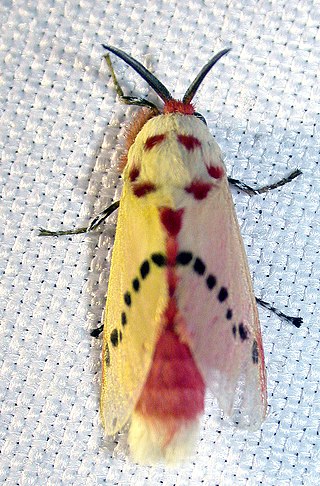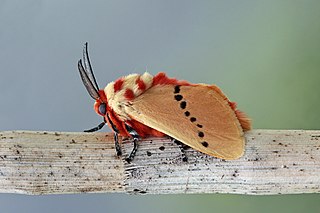
The Ecuador national football team represents Ecuador in men's international football and is controlled by the Ecuadorian Football Federation (FEF). They joined FIFA in 1926 and CONMEBOL a year later.

The Venezuela national football team represents Venezuela in men's international football and is controlled by the Venezuelan Football Federation (FVF), the governing body for football in Venezuela. They are nicknamed La Vinotinto. When playing at home in official games, they usually rotate between three stadiums: The Polideportivo Cachamay in Puerto Ordaz, the Estadio José Antonio Anzoátegui in Puerto La Cruz and the Estadio Pueblo Nuevo in San Cristóbal. In friendly matches, they tend to rotate between the rest of the stadiums in the country.
Cibyra is a genus of moths of the family Hepalidae. There are 50 described species, found throughout Central and South America.
Dalaca is a genus of moths of the family Hepialidae. There are 23 described species found throughout South America as far north as Panama. The larvae feed on grasses.

Arsenura armida, the giant silk moth, is a moth of the family Saturniidae. It is found mainly in South and Central America, from Mexico to Bolivia, and Ecuador to south-eastern Brazil. It was first described by Pieter Cramer in 1779.

Arsenura rebeli is a moth of the family Saturniidae. It is found in the Andes, from Ecuador, south to Bolivia.

Rachiplusia ou, commonly known as the gray looper moth, is a species of moth in the family Noctuidae. The species was first described by Achille Guenée in 1852. It is found in the southern and eastern parts of the United States, Montana, Nova Scotia, from Mexico to Venezuela to Ecuador and the Dominican Republic.

Anthanassa frisia, the Cuban crescentspot, Cuban checkerspot or Cuban crescent, is a butterfly of the family Nymphalidae. Subspecies tulcis is known by the common names pale-banded crescent or Tulcis crescent; it is treated as a species by some authors. The nominate subspecies is found in the West Indies and southern Florida, with strays to northern Florida. Subspecies tulcis is found from Argentina north through Central America and Mexico to southern Texas, strays to west Texas and southern Arizona. Other subspecies are resident to South America.

Automeris larra is a moth of the family Saturniidae. It is found in South America, including Brazil, French Guiana, Venezuela, Colombia, Peru, Bolivia and Ecuador.

Automeris metzli is a moth of the family Saturniidae. It is found from Mexico to Venezuela, Colombia and Ecuador and can also be found in Trinidad

Arsenura is a genus of moths in the family Saturniidae. The genus was erected by James Duncan and John O. Westwood in 1841.

Arsenura pandora is a moth of the family Saturniidae. It is known from Brazil.

Adaina zephyria is a moth of the family Pterophoridae first described by William Barnes and Arthur Ward Lindsey in 1921. It is found in the United States (California), Mexico (Oaxaca), Peru (Huanaca), Venezuela, Bolivia, Costa Rica and Ecuador.

Amauta papilionaris is a moth in the Castniidae family. It is found in Colombia, Venezuela, Peru, Bolivia, Ecuador and Panama.
Dalaca niepelti is a species of moth of the family Hepialidae. It is known from Ecuador.

Marpesia zerynthia, the waiter daggerwing, is a species of butterfly in the family Nymphalidae. Primarily found in Mesoamerica, it can also be observed in regions slightly north and south of this area.
Agyrtidia olivensis is a moth of the subfamily Arctiinae. It was described by Joaquim P. Machado Filho and Alfredo Rei do Régo Barros in 1970. It is found in Brazil.

Issiaga Sylla is a Guinean professional footballer who plays as a left-back for Ligue 1 club Montpellier and the Guinea national team.

Trosia dimas, the rosy ermine, is a moth in the family Megalopygidae. It is found in Colombia, Venezuela, Ecuador, Brazil, and Peru.

Trosia nigropunctigera, commonly known as the rosy ermine moth, is a lepidopteran in the family Megalopygidae native to the Neotropics. These moths have a wingspan of 45-60mm, and are distributed across Costa Rica, Panama, Colombia, Venezuela, Guyana, Ecuador and Peru. The species was first described by David Stephen Fletcher in 1982.















